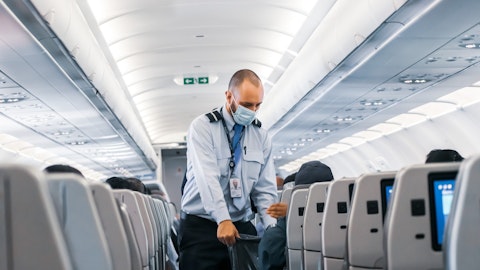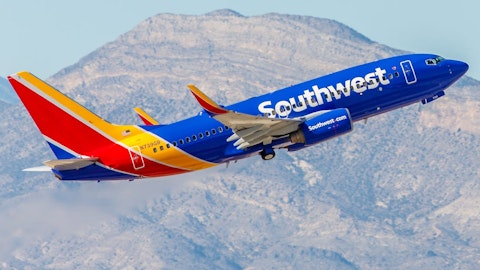Mesa Air Group, Inc. (NASDAQ:MESA) Q1 2023 Earnings Call Transcript February 9, 2023
Operator: Thank you for standing by, and welcome to the Mesa Airlines’ Q1 Fiscal Year 2023 Conference Call. All participants are in a listen-only mode until the question-and-answer session of today’s call. This call is being recorded. If you have any objections, disconnect at this time. I would now like to turn the call over to Doug Cooper, Head of Investor Relations. Mr. Cooper, you may now begin.
Doug Cooper: Thank you, Christina and welcome everyone to Mesa’s earnings conference call for its fiscal first quarter 2023 ended December 31st, 2022. On the call with me today are Jonathan Ornstein, Mesa’s Chairman and Chief Executive Officer; Brad Rich, Executive Vice President and Chief Operating Officer; Michael Lotz, President; Torque Zubeck, Chief Financial Officer; and other members of the management team. Following our prepared remarks, there will be a question-and-answer session for the sell-side analysts. We also want to remind everyone on the call today that today’s discussion contains forward-looking statements that are based on the company’s current expectations and are not a guarantee of future performance. There could be significant risks and uncertainties that could cause actual results to differ materially from those reflected by the forward-looking statements, including the risk factors discussed in our reports on file with the SEC.
We undertake no duty to update any forward-looking statements. In comparing results today, we will be adjusting all periods to exclude special items. Please refer to our fiscal first quarter earnings release, which is available on our website for the reconciliation of our non-Admeasures. With that, I will turn the call over to Jonathan for his opening remarks. Jonathan?
Jonathan Ornstein: Thank you, Doug, and thank you everyone for being on with us today. We’re pleased to be speaking to you again after introducing several major developments at Mesa on our fourth quarter call six weeks ago. As you may know, we had a busy December quarter, negotiating and finalizing significant agreements with our airline partners and other key financial parties. We expect these new agreements will substantially enhance our operational performance and both our income statement and balance sheet. Since our last call, we have been working diligently as we prepare to wind down our loss-making operation with American Airlines and transition our CRJ-900 flying to United Airlines next month. For the quarter, we had an adjusted net loss of $4.3 million on revenue of $147.2 million.
While traffic remained strong and our pilot pipeline has improved significantly, capacity remains constrained as we catchup with unprecedented attrition experienced as a result of the industry-wide pilot shortage. Here’s a quick overview of what we have recently accomplished. First and foremost, we eliminated our loss-making operation at American Airlines effective April 3rd, 2023. Pursuant to that wind down, United agreed to add up to 40 CRJ-900s previously operated for American. To improve our balance sheet, we sold our remaining 8 CRJ-550s and agreed to sell down 11 CRJ-900s and 30 GE engines, reducing approximately $90 million of debt and generating approximately $70 million of cash. Additionally, United replaced our $16 million balance on our revolving credit line and provide an additional $25 million loan.
We also restructured our RASPRO leases and EDC debt. Finally, we implemented new pay scales with our pilots and a new agreement with our flight attendants. Looking forward, the current quarter is all about a successful transition. Working closely with United, we intend to keep all the related crew domiciles and maintenance bases open. With our significant focus on operations, we believe the new United 900 flying will perform at levels similar to our existing E-Jet flying at United. In some good news on the pilot front, we continue to see strong levels of applications and reduced attrition. Currently, our monthly pilot attrition declined and has now stabilized approximately near pre-COVID levels. This week, we announced a direct entry captain position for qualified candidates.
Highlights of the program include a 24-month flow to United Airlines and an industry-leading $110,000 sign-on bonus. Combined with our industry-leading pay rates, we believe this may be the best opportunity in the history of regional aviation for pilots to advance their careers. We are continuing to focus on pilot training, throughput, and have increased our resources around it. Brad will get into more detail on this later on. Last fall, we officially launched our Mesa Pilot Development or MPD program and recently welcomed our first graduates to the Mesa regional pilot ranks. As our — with our significantly increased pay scale and participation in United Aviate program as well as our expanding training pipeline provided by MPD program and our new direct entry captain program, we believe Mesa provides a reliable and rapid path for pilots to join the regional industry and transition to United Airlines.
We are pleased to be within the United ecosystem and are committed to training, retaining, and promoting pilots through to United. I’m also pleased to announce that we are adding a 737-800 freighter to our DHL operation. We have taken delivery of the aircraft and expect it to enter service in March. This brings our total cargo fleet to three 737-400s and one next-gen 737-800. At this point, I’d like to turn to highlights from the past few months that speak to the leadership position that Mesa is building in the future of regional aviation and the greater sustainability that we hope to help enable the industry in years ahead. The two electric flight partnerships we invested in with United, Archer and Heart recently achieved significant milestones.
Archer unveiled its new five-seat eVTOL titled Midnight in November. Midnight is set to provide a sustainable form of aviation that can service short distance trips between regional airports and city centers. Heart Aerospace also continued to make progress, meaning a number of milestones and garnering additional commercial aircraft orders. We believe Mesa is the vanguard of innovation in eco-friendly electric aviation and will continue to assess opportunities going forward. Meanwhile, our European joint venture, FLYHT , is on track to complete its operating certificate this spring, while initially operate regional jets, we believe FLYHT could also be a platform for us to expand new technology and eco-friendly flying in environmentally sensitive European markets.
With that, I will hand it over to Brad Rich to go over more of the details of our operational performance this quarter.

Photo by William Topa on Unsplash
Brad Rich: Thank you, Jonathan and good afternoon to everyone. I’d like to start by reviewing our quarterly operating results. In the December quarter, we flew 50,940 block hours, 9.6% below last quarter, roughly in line with our previous forecast. Our March quarter block hours are projected to be roughly flat versus the December quarter. Mesa, like many regional airlines, continues to contend with the challenges of the industry-wide pilot shortage on our block hour production. However, we finally have a line of sight to relief. As Jonathan mentioned, attrition has come down materially over the past few months, and our classes are filled with a combination of new hires and captain upgrades. Pilot production remains our highest priority.
We continue to increase our in-house training capacity from the additional CRJ and E-Jet instructors that we have hired. We have also contracted with CAE to provide both instructors and more sim capacity this year. We remain focused on our transition to United and are continuing to work closely with their teams to prepare facilities, crews and maintenance efforts for CRJ-900 flying. The rollout that we outlined on last quarter’s call remains unchanged. We expect to operate our current 24 lines of flying with American through February 28th before reducing flights throughout March and ceasing American operations on April 3rd. We will begin operating CRJ-900s for United on March 3rd and will transition all the flying by May. As previously mentioned, United is covering the expenses to reconfigure and rebrand the CRJ-900 aircraft.
With that, I’ll now turn the call over to Torque to walk through our financial performance.
Torque Zubeck: Thank you, Brad. I’ll take this opportunity now to review our financial performance and our balance sheet. For the first quarter of fiscal year 2023, revenue was $147.2 million, relatively flat compared to $147.8 million in Q1 2022. Contract revenues fell by $8.4 million year-over-year, driven primarily by lower block hours, partially offset by increased block hour revenue for our new pilot pay scale. Pass-through and other revenue increased by $7.9 million, primarily due to E-Jet maintenance, faster revenue and deferred revenue. Mesa’s Q1 2023 results include, per GAAP, the recognition of $5.3 million of previously deferred revenue versus the recognition of $4.2 million in Q1 2022. The remaining deferred revenue balance of $18.8 million will be recognized as flights are completed over the remaining terms of the contract.
On the expense side, Mesa’s overall operating expenses for Q1 2023 were $144.7 million, down $7 million versus Q1 2022. This decrease was driven by lower maintenance expense, which fell $10.7 million or 18.1%versus Q1 2022 to $48.3 million. It’s primarily due to fewer seat checks than in the first quarter last year as well as lower aircraft rent, which fell by $5.5 million and depreciation and amortization expense, which fell by $5.8 million. The decline in depreciation and amortization expense is primarily due to reduced asset values as a result of assets held for sale and year-end impairments. These factors were partially offset by higher flat operational expense of $10.7 million due to increased training costs and the implementation of higher pilot pay scale as well as $3.7 million in intangible asset impairment.
On the bottom-line, we reported a net loss of $9.1 million or $0.25 per diluted share compared to a net loss of $14.3 million or $0.40 per diluted share for Q1 2022. On an adjusted basis, Mesa reported a loss of $4.3 million or $0.12 per share compared to a net loss of $9.3 million or $0.26 per share a year ago. The adjusted loss of Q1 2023 excludes a $3.7 million impairment loss and another $1.7 million mark-to-market non-cash loss on our investments in equity securities. Adjusted results from Q1 2022 excludes a $6.5 million mark-to-market non-cash loss on our investments in equity securities. Next, let me turn to cash and liquidity. Cash for the quarter, excluding restricted cash, decreased by $1.6 million from the prior quarter ending September 30th, 2022, at $56.1 million, in line with the projection on our fourth quarter call.
This amount excludes net proceeds from the sales that were not closed as of December period end, including our eight CRJ-550s, 11 900s, and the spared engines that Jonathan reviewed at the top of the call. Total debt at the end of the quarter was $701.3 million, up $86 million from the prior quarter. This amount includes $64.2 million corresponding to the GAAP reclassification from our operating lease to finance lease on 15 CRJ-900s. Additionally, we borrowed $25.5 million in the form of term loan from United, of which $15 million is forgivable upon the meeting of certain performance criteria. During the quarter, we also made scheduled debt payments of $17.5 million and finance lease payments of $3.5 million. As a reminder, we have $74 million of scheduled principal payments remaining in 2023 and after the repayment of debt associated with asset sales, we expect fiscal year 2023 year-end debt of approximately $535 million.
This updated total from $435 million that we were expecting as of last quarter’s call, primarily reflects the net impact of the reclassification of the RASPRO operating lease to a finance lease. With regard to fiscal full year 2023, given the ongoing major developments at Mesa that we will not be providing specific financial guidance at this time other than the block hours for the March quarter that was discussed by Brad earlier, and the total debt figure that I just mentioned. We would like to point out that this quarter had favorable adjustments of $7 million. Based on our transition with American, we expect our deferred revenue to decrease by $11 million next quarter. Additionally, given the United’s equity stake in Mesa is 10%, our current share count is approximately 40 million.
With that, I’d like to now turn it back over to Jonathan for closing remarks.
Jonathan Ornstein: Thank you, Torque. In summary, our first fiscal quarter of 2023 was a critically important one for Mesa and one in which we believe we achieved a lot and made significant progress. That said, we have a lot of work ahead of us. We continue to focus on pilot development in order to increase our block hour production first and foremost. At this point, please open up for additional questions that the analysts may have.
See also 16 Most Valuable Beverage Brands in the World and Top 10 Global Risks for 2023.
Q&A Session
Follow Mesa Air Group Inc (NASDAQ:MESA)
Follow Mesa Air Group Inc (NASDAQ:MESA)
Receive real-time insider trading and news alerts
Operator: Thank you. Our first question today comes from Savi Syth with Raymond James. Go ahead please, your line is open.
Savi Syth: Hey, good afternoon everyone. Just as wondering, with this December quarter, you talked about losing about $5 million a month on the American contract. And in light of that, it seems like the earnings result is pretty good. Is that a function of some of that deferred revenues showing up? Or if this trend holds, why shouldn’t we expect kind of profitability by kind of the June quarter?
Torque Zubeck: Yes, hey Savi, this is Torque. Yes, we recognized a fair amount of deferred revenue just given the change in the contract term with American Airlines. That’s the biggest change in the quarter.
Savi Syth: Okay. So, kind of going forward, I should kind of consider the underlying ex that as the base going forward?
Torque Zubeck: Not quite clear, Savi. Could you repeat?
Savi Syth: Yes. So, just for the — I guess, as we think about the core United earnings power here, should we think about it as take out the revenue recognition and maybe take out the $15 million in losses that will go away, and that’s your core until you start building up your block hours? Is that how we should think about it?
Torque Zubeck: Yes, we have some tail with American Airlines, expenses that are covered for the next upcoming quarter. But yes, if you defer the — or eliminate the deferred revenue, then yes, that would be close to what we would expect moving forward.
Savi Syth: Got it. And then if I might, on the pilot side, which is kind of good news. If kind of the attrition levels here hold at close to pre-pandemic levels, how long — given your kind of increased trading throughput, how long do you think it will take to then be able to fly the full complement that you want to fly?
Jonathan Ornstein: Savi, this is Jonathan. It’s really depend on, to some degree, the mix of aircraft. We are moving CRJs over. But I mean, I think our preference and United’s preference should be to fly as many of the 175s as we can. And so we’ve got sort of two training pipelines going. I would suggest, depending on what you call maximum utilization, for example, if we could fly 11.5 hours, we’d probably be at the outside, call it, it could be as long as 18 months, and that would be conservative. However, in spite of the fact that we’d like to fly as much as possible, sometimes network is just not capable of getting that much time on every airplane. So, if we are around 10 hours, it could be probably 12 months, maybe a little better than that based on the current trends.
But I do have to warrant everyone. I mean, these trends are very volatile. And we got a good jump with what we did in terms of the pay rates and some of the programs we put in place. We’ve got a really strong development program now with Mesa pilot development. But as you know, one of the problems that has been created by this legislation has been the fact that we’ve had this big attrition throughout the regional industry. And we’re just running out of people to upgrade to captain and that is becoming an overwhelming issue where you’re going to end up with trying to get people to 1,000 hours and get them to upgrade and not immediately get hired away by another carrier. Now, with the aviate program in place and with our pay structure, we think we will have addressed that to some degree.




